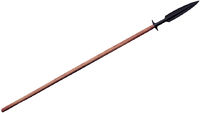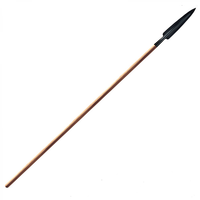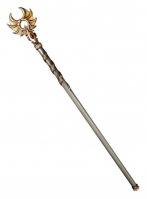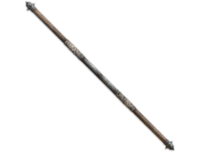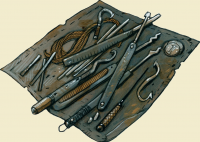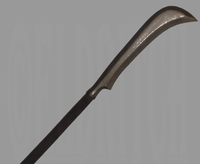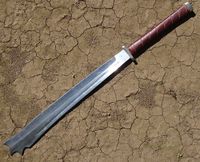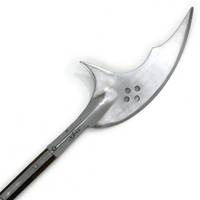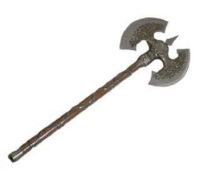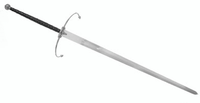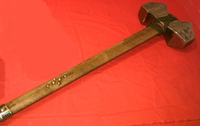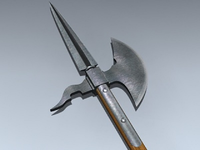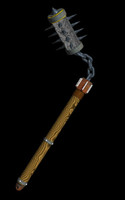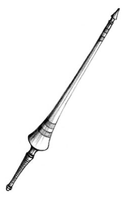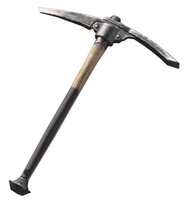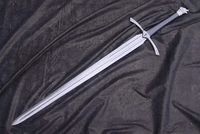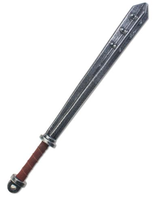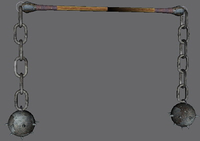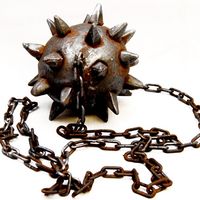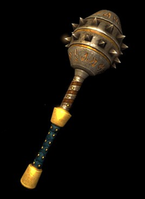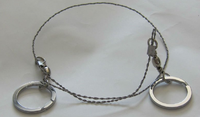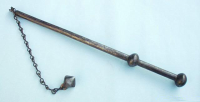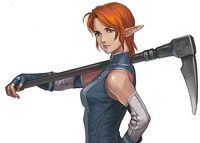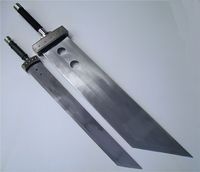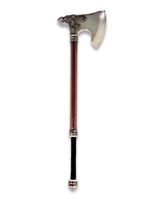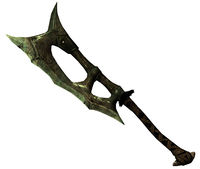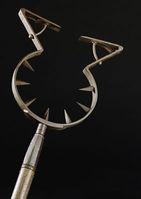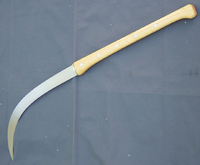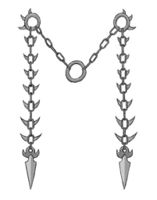2-Hand Melee Weapons: Difference between revisions
| (151 intermediate revisions by 4 users not shown) | |||
| Line 1: | Line 1: | ||
[[Category: | [[Category:Epic Path]][[Category:Catalog Page]] | ||
[[Category: | <div style="clear">__TOC__</div> | ||
== Magic Weapons == | |||
Rules for the creation, cost and effects of magic weapons can be found on the following pages: | |||
* [[Magic Weapons]] | |||
* [[Dweomermetals]] | |||
* [[Melee Magic Properties]] | |||
* [[Ranged Magic Properties]] | |||
* [[Reforging]] | |||
==== | == Simple Weapons == | ||
{ | <p> | ||
{{:Boar Spear (Weapon)}} | |||
</p> | |||
<p> | |||
{{:Long Spear (Weapon)}} | |||
</p> | |||
<p> | |||
{{:Mage's Staff (Weapon)}} | |||
</p> | |||
<p> | |||
{{:Quarterstaff (Weapon)}} | |||
</p> | |||
<p> | |||
{{:Spear (Weapon)}} | |||
</p> | |||
<p> | |||
{{:Thieves' Tools (Weapon)}} | |||
</p> | |||
<br> | |||
==== | ==Martial Weapons== | ||
{ | <p> | ||
{{:Bardiche (Weapon)}} | |||
</p> | |||
<p> | |||
{{:Bill (Weapon)}} | |||
</p> | |||
<p> | |||
{{:Falchion (Weapon)}} | |||
</p> | |||
<p> | |||
{{:Glaive (Weapon)}} | |||
</p> | |||
<p> | |||
{{:Greataxe (Weapon)}} | |||
</p> | |||
<p> | |||
{{:Greatsword (Weapon)}} | |||
</p> | |||
<p> | |||
{{:Great Club (Weapon)}} | |||
</p> | |||
<p> | |||
{{:Great Hammer (Weapon)}} | |||
</p> | |||
<p> | |||
{{:Halberd (Weapon)}} | |||
</p> | |||
<p> | |||
{{:Heavy Flail (Weapon)}} | |||
</p> | |||
<p> | |||
{{:Lance (Weapon)}} | |||
</p> | |||
<p> | |||
{{:Pickaxe (Weapon)}} | |||
</p> | |||
<p> | |||
{{:Scythe (Weapon)}} | |||
</p> | |||
<p> | |||
{{:Two-Handed Bastard Sword (Weapon)}} | |||
</p> | |||
<br> | |||
==== | ==Exotic Weapons== | ||
<p> | |||
{{:Cruciate Maul (Weapon)}} | |||
</p> | |||
<p> | |||
{{:Dire Flail (Weapon)}} | |||
</p> | |||
<p> | |||
{{:Dorn Dergar (Weapon)}} | |||
</p> | |||
<p> | |||
{{:Dread Maul (Weapon)}} | |||
</p> | |||
{ | <p> | ||
{{:Dwarven Urgrosh (Weapon)}} | |||
</p> | |||
<p> | |||
{{:Fauchard (Weapon)}} | |||
</p> | |||
<p> | |||
{{:Flambard (Weapon)}} | |||
</p> | |||
<p> | |||
{{:Flickerspike (Weapon)}} | |||
</p> | |||
<p> | |||
{{:Garrote (Weapon)}} | |||
</p> | |||
<p> | |||
{ | {{:Great Flail (Weapon)}} | ||
</p> | |||
<p> | |||
{{:Great Pick (Weapon)}} | |||
</p> | |||
<p> | |||
{{:Great Whip (Weapon)}} | |||
</p> | |||
<p> | |||
{{:Godsword (Weapon)}} | |||
</p> | |||
<p> | |||
{{:Hafted War Axe (Weapon)}} | |||
</p> | |||
<p> | |||
{{:Harpoon (Weapon)}} | |||
</p> | |||
<p> | |||
{{:Imperial Axe (Weapon)}} | |||
</p> | |||
<p> | |||
{{:Mancatcher (Weapon)}} | |||
</p> | |||
<p> | |||
{ | {{:Ogre Hook (Weapon)}} | ||
</p> | |||
<p> | |||
{{:Spiked Chain (Weapon)}} | |||
</p> | |||
<p> | |||
{{:Two-Bladed Sword (Weapon)}} | |||
</p> | |||
<br> | |||
{ | |||
{ | |||
{ | |||
{ | |||
{ | |||
{ | |||
{ | |||
{ | |||
{ | |||
{ | |||
{ | |||
{ | |||
{ | |||
{ | |||
{ | |||
{ | |||
{ | |||
{ | |||
{ | |||
{ | |||
{ | |||
{ | |||
{ | |||
{ | |||
{ | |||
Latest revision as of 18:45, 5 February 2022
Magic Weapons
Rules for the creation, cost and effects of magic weapons can be found on the following pages:
Simple Weapons
| Boar Spear | 2-Hand / Simple | [edit] | |||||||
|---|---|---|---|---|---|---|---|---|---|
| Cost | Sm Dmg | Med Dmg | Large Dmg | Crit | Range | Wt | Type | ||
| 5 gp | 1d6 | 1d8 | 2d6 | x2 | - | 8 lbs | Piercing (physical, common) | ||
| Weapon Qualities: Brace, Charge Defense, Defensive | |||||||||
| Take a regular spear and reinforce it, using a bigger head, and a thicker shaft. Add a set of crossbars below the head, too, to stop creatures from charging down the shaft. You wind up with the boar spear, which does less critical damage than a regular spear due to the extra weight, but is much safer if you hit a charging foe. The Boar Spear belongs to the "Spears" weapon group. | |||||||||
| Long Spear | 2-Hand / Simple | [edit] | |||||||
|---|---|---|---|---|---|---|---|---|---|
| Cost | Sm Dmg | Med Dmg | Large Dmg | Crit | Range | Wt | Type | ||
| 5 gp | 1d6 | 1d8 | 2d6 | x3 | - | 9 lbs | Piercing (physical, common) | ||
| Weapon Qualities: Brace, Defensive, Reach | |||||||||
| A long spear is exactly what it sounds like: A longer spear. The extra two to three feet of length makes them more clumsy to throw than their shorter cousins, but grants them the ability to attack squares 10 feet (2 squares) from the wielder, although they cannot attack squares adjacent to the wielder. The long spear belongs to the "Spears" weapon group. | |||||||||
| Mage's Staff | 2-Hand / Simple | [edit] | |||||||
|---|---|---|---|---|---|---|---|---|---|
| Cost | Sm Dmg | Med Dmg | Large Dmg | Crit | Range | Wt | Type | ||
| 80 gp | 1d4/1d4 | 1d6/1d6 | 1d10/1d10 | x2 | - | 7 lbs | Bludgeoning (physical, common) | ||
| Weapon Qualities: Double, Touch, Implement | |||||||||
| A mage's staff is a high-quality variant of a quarterstaff. In fact, feats and other abilities that apply to a quarterstaff can also be applied to a mage's staff. In addition, mage's staves can be used to make melee touch attacks instead of standard melee attacks, at the expense of ignoring the user's strength modifier (or any ability score that they use in place of strength) for purposes of damage (it does not affect their to-hit number, other than the bonus granted by making a melee touch attack). This can be a good thing if the user's strength score is below 10. Finally, a mage's staff counts as a magic implement, if the wielder's class grants an Implement Bonus. A mage's staff belongs to the "Double" weapon group. | |||||||||
| Quarterstaff | 2-Hand / Simple | [edit] | |||||||
|---|---|---|---|---|---|---|---|---|---|
| Cost | Sm Dmg | Med Dmg | Large Dmg | Crit | Range | Wt | Type | ||
| 1 gp | 1d4/1d4 | 1d6/1d6 | 1d10/1d10 | x2 | - | 4 lbs | Bludgeoning (physical, common) | ||
| Weapon Qualities: Double, Monk-Usable, Primitive Availability | |||||||||
| Never has a device so simple had such power. Despite the extremely basic design and low, low cost, a person with a quarterstaff is actually very well armed. A quarterstaff can be used with no skill exactly as its shorter cousin, the club. But in the hands of a skillful user, the quarterstaff is a double weapon, attacking as two clubs, and the more skill the user has, the more dangerous this simple stick gets. And as if that weren't enough, the quarterstaff can also be used by monks, who can show you how to really use a fallen tree branch. The Quarterstaff belongs to the "Double" and "Monk" weapon groups. | |||||||||
| Spear | 2-Hand / Simple | [edit] | |||||||
|---|---|---|---|---|---|---|---|---|---|
| Cost | Sm Dmg | Med Dmg | Large Dmg | Crit | Range | Wt | Type | ||
| 2 gp | 1d6 | 1d8 | 2d6 | x3 | 20 ft | 6 lbs | Piercing (physical, common) | ||
| Weapon Qualities: Brace, Defensive, Melee Capable, Primitive Availability | |||||||||
| Take a hefty five foot long stick, put a nice sharp blade on the end, and you have a spear. Spears are simple, economical, and for the investment, about the best weapons ever invented. If you need to arm thousands of troops really fast, you use spears. They hit extremely hard, they can be thrown for good distances, and they can brace to discourage charging opponents. The Spear belongs to the "Spears" and "Thrown" weapon groups. | |||||||||
| Thieves' Tools | 2-Hand / Simple | [edit] | |||||||
|---|---|---|---|---|---|---|---|---|---|
| Cost | Sm Dmg | Med Dmg | Large Dmg | Crit | Range | Wt | Type | ||
| 30 gp | 1d3 | 1d4 | 1d6 | x2 | - | 3 lbs | Piercing (physical, common) | ||
| Weapon Qualities: Finesse, Trapbreaker, Special | |||||||||
| Thieves' Tools are technically a weapon used in two hands, even though the tools themselves are individually quite small. But if you are in the middle of working a trap and have to break off and tackle that monster about to eat the sorcerer, and you don't want to drop your tools to pull a real weapon, Thieves' Tools can be jammed into a monster's eyeball just fine. For a two-handed weapon, their damage is awful, but they can serve in an emergency. Thieves' Tools belong to the "Close" weapons group.
Special: Thieves' Tools are treated as a dagger (just one, despite requiring both hands, and despite having no throwing range) for all game purposes, such as feats, class features, racial traits, etc. | |||||||||
Martial Weapons
| Bardiche | 2-Hand / Martial | [edit] | |||||||
|---|---|---|---|---|---|---|---|---|---|
| Cost | Sm Dmg | Med Dmg | Large Dmg | Crit | Range | Wt | Type | ||
| 13 gp | 1d8 | 1d10 | 2d8 | 19-20 x2 | - | 12 lbs | Slashing (physical, common) | ||
| Weapon Qualities: Brace, Reach, Stout, Hewing | |||||||||
| A bardiche has a huge curving blade which attaches to its sturdy haft in two places. They are useful polearms, with the added advantage of being extremely durable due to their solid and redundant construction techniques. They are long enough that they allow attacks and threaten against squares ten feet (2 squares) from the wielder, but do not allow attacks or threaten adjacent squares. A bardiche adds a +2 bonus to the users Maneuver Defense to resist sunder attempts. The Bardiche belongs to the "Axes" and "Polearms" weapon groups. | |||||||||
| Bill | 2-Hand / Martial | [edit] | |||||||
|---|---|---|---|---|---|---|---|---|---|
| Cost | Sm Dmg | Med Dmg | Large Dmg | Crit | Range | Wt | Type | ||
| 8 gp | 1d10 | 3d4 | 5d4 | x3 | - | 10 lbs | Slashing (physical, common) | ||
| Weapon Qualities: Pilfering, Reach | |||||||||
| A bill is a hefty forward hooked blade sharpened on the inner curve only. They are simple and sturdy devices, granting the user reach, and they hit really hard, even for polearms. Bills are surprisingly common as tools and farm implements, where they are called brush hooks or pruning hooks. In the hands of a user with martial weapons skill, the lowly farm implement becomes an extremely lethal, if unsophisticated, weapon. They are long enough that they allow attacks and threaten against squares ten feet (2 squares) from the wielder, but do not allow attacks or threaten adjacent squares. The Bill belongs to the "Polearms" weapon group. | |||||||||
| Falchion | 2-Hand / Martial | [edit] | |||||||
|---|---|---|---|---|---|---|---|---|---|
| Cost | Sm Dmg | Med Dmg | Large Dmg | Crit | Range | Wt | Type | ||
| 30 gp | 1d10 | 1d12 | 3d6 | 19-20 x2 | - | 8 lbs | Hacking (physical, uncommon) | ||
| Weapon Qualities: Deceptive, Pilfering | |||||||||
| The falchion is the smallest and least sophisticated of the heavy two-handed swords. But this does not mean the falchion is a poor weapon! The compact dimensions and solid construction make the falchion surprisingly fast to maneuver, and as a result a falchion can score many dangerous critical hits. The Falchion belongs to the "Blades, Heavy" weapon group, and is treated as a slashing weapon for the application of Weapon Properties, Feats, Dweomermetals and all other effects. | |||||||||
| Glaive | 2-Hand / Martial | [edit] | |||||||
|---|---|---|---|---|---|---|---|---|---|
| Cost | Sm Dmg | Med Dmg | Large Dmg | Crit | Range | Wt | Type | ||
| 11 gp | 1d6 | 1d8 | 2d6 | x3 | - | 11 lbs | Slashing (physical, common) | ||
| Weapon Qualities: Blocking, Brace, Disarm, Dismounting, Reach | |||||||||
| The blade of this polearm is a curved chopping blade with a spiked projection on the back of the blade. The spike is commonly used to block and parry. Despite the fairly simple design, the glaive is remarkably handy in combat. When fighting defensively or with full defense, this weapon gives you a +1 shield bonus to AC. A mounted opponent hit by a glaive takes a -1 penalty on his Ride checks to stay mounted. Sadly, a glaive does not hit as hard as some other polearms. They are long enough that they allow attacks and threaten against squares ten feet (2 squares) from the wielder, but do not allow attacks or threaten adjacent squares. The Glaive belongs to the "Polearms" weapon group. | |||||||||
| Greataxe | 2-Hand / Martial | [edit] | |||||||
|---|---|---|---|---|---|---|---|---|---|
| Cost | Sm Dmg | Med Dmg | Large Dmg | Crit | Range | Wt | Type | ||
| 20 gp | 1d10 | 1d12 | 3d6 | x3 | - | 12 lbs | Hacking (physical, uncommon) | ||
| Weapon Qualities: Battering, Stout | |||||||||
| A greataxe is a larger, meaner, two-handed version of the battle axe, and a perennial favorite of barbarians everywhere. There's nothing that says 'barbaric' like a big honkin' axe. The Greataxe belongs to the "Axes" weapon group, and is treated as a slashing weapon for the application of Weapon Properties, Feats, Dweomermetals and all other effects. | |||||||||
| Greatsword | 2-Hand / Martial | [edit] | |||||||
|---|---|---|---|---|---|---|---|---|---|
| Cost | Sm Dmg | Med Dmg | Large Dmg | Crit | Range | Wt | Type | ||
| 50 gp | 1d10 | 2d6 | 3d6 | 19-20 x2 | - | 8 lbs | Slashing (physical, common) | ||
| Weapon Qualities: Hewing | |||||||||
| To many, the greatsword is the king of the large martial swords. It is longer and more sophisticated than the falchion, and quicker and more refined than the massive godsword. The flambard is amazing, but so hard to use well.... In the eyes of many warriors, the greatsword is the best no-nonsense, no-frills, get the job done weapon out there. The Greatsword belongs to the "Blades, Heavy" weapon group. | |||||||||
| Great Club | 2-Hand / Martial | [edit] | |||||||
|---|---|---|---|---|---|---|---|---|---|
| Cost | Sm Dmg | Med Dmg | Large Dmg | Crit | Range | Wt | Type | ||
| 5 gp | 1d8 | 1d10 | 2d8 | x2 | - | 8 lbs | Buffeting (physical, uncommon) | ||
| Weapon Qualities: Battering, Defensive, Stout | |||||||||
| A great club is the larger, two-handed version of the reliable old club. A great club is shorter and much heavier than a quarterstaff, and is almost always worked over by a craftsman to improve its performance in combat. A great club is nothing fancy, but it will certainly get the job done and can be bought or made almost anywhere out of almost anything. The great club belongs to the "Hammers" weapon group, and is treated as a bludgeoning weapon for the application of Weapon Properties, Feats, Dweomermetals and all other effects. | |||||||||
| Great Hammer | 2-Hand / Martial | [edit] | |||||||
|---|---|---|---|---|---|---|---|---|---|
| Cost | Sm Dmg | Med Dmg | Large Dmg | Crit | Range | Wt | Type | ||
| 40 gp | 1d10 | 2d6 | 3d6 | x3 | - | 14 lbs | Bludgeoning (physical, common) | ||
| Weapon Qualities: Battering, Stout | |||||||||
| The great hammer is the big brother of the Light Mace and Heavy Mace. It's not a sophisticated weapon by any stretch, having a simple head of hard, heavy material and a sturdy handle. But what it lacks in sophistication it makes up in simple rugged utility. Indeed, great hammers are very commonly seen being used as tools to break stone, drive spikes, split wood with wedges, and otherwise getting work done. In the hands of a user with skill in martial weapons, however, having a great hammer means you're always going to effective in a fight. The great hammer belongs to the "Hammers" weapon group. | |||||||||
| Halberd | 2-Hand / Martial | [edit] | |||||||
|---|---|---|---|---|---|---|---|---|---|
| Cost | Sm Dmg | Med Dmg | Large Dmg | Crit | Range | Wt | Type | ||
| 10 gp | 1d8 | 1d10 | 2d8 | x3 | - | 12 lbs | Piercing (physical, common) or Slashing (physical, common) | ||
| Weapon Qualities: Adaptive Reach, Brace, Dismounting, Trip | |||||||||
| The halberd is the weapon of choice for professional military's everywhere. It can be used in general melee, is good against the charge, and can put opponents on the ground, all at a very reasonable price and while doing solid damage. There are other weapons that do some things better, but for all around utility, the halberd is hard to beat. The Halberd belongs to the "Polearms" weapon group. | |||||||||
| Heavy Flail | 2-Hand / Martial | [edit] | |||||||
|---|---|---|---|---|---|---|---|---|---|
| Cost | Sm Dmg | Med Dmg | Large Dmg | Crit | Range | Wt | Type | ||
| 15 gp | 1d8 | 1d10 | 2d8 | 19-20 x2 | - | 10 lbs | Bludgeoning (physical, common) or Piercing (physical, common) | ||
| Weapon Qualities: Disarm, Intimidating, Trip | |||||||||
| A heavy flail has a handle quite similar to a flail, except with more space for gripping and stronger hardware. The chain is much heftier than a standard flail as well. The big difference is in the striking head. On a heavy flail, the striking head is twice as large and cylinder shaped, not to mention still liberally equipped with spikes. The heavy flail is still a flexible weapon, and gives bonuses to trip and disarm attempts. The Heavy Flail belongs to the "Flails" weapon group. | |||||||||
| Lance | 2-Hand / Martial | [edit] | |||||||
|---|---|---|---|---|---|---|---|---|---|
| Cost | Sm Dmg | Med Dmg | Large Dmg | Crit | Range | Wt | Type | ||
| 10 gp | 1d6 | 1d8 | 2d6 | x3 | - | 10 lbs | Piercing (physical, common) | ||
| Weapon Qualities: Double Charge Damage, Reach, Special | |||||||||
| The lance is a real oddball among two-handed weapons. The balance of the lance is very strongly shifted back to the grip, since even as a two-handed weapon, it is meant to be used while seated, riding a mount, and in one hand. The other hand is handling a shield and holding the reins of the mount. The very light tip makes using the lance not only possible but extremely deadly. When couched proficiently and used in a charge, a lance does double damage or more. Compared to other two-handed weapons, the lance does not do a lot of damage, but when used in its specialized niche, there is nothing deadlier. They are long enough that they allow attacks and threaten against squares ten feet (2 squares) from the wielder, but do not allow attacks or threaten adjacent squares. The Lance belongs to the "Spears" weapon group. | |||||||||
| Pickaxe | 2-Hand / Martial | [edit] | |||||||
|---|---|---|---|---|---|---|---|---|---|
| Cost | Sm Dmg | Med Dmg | Large Dmg | Crit | Range | Wt | Type | ||
| 14 gp | 1d6 | 1d8 | 2d6 | 19-20 x3 | - | 12 lbs | Spindling (physical, rare) | ||
| Weapon Qualities: Blocking, Sunder | |||||||||
| The Pickaxe is the martial, two-handed iteration of the light pick and heavy pick weapons. Pickaxes are actually quite common, although they are usually used as heavy earth and stone breaking tools. In the hands of someone skilled with martial weapons, however, the lowly tool becomes one of the most fearsome weapons available. The pickaxe does not do severe damage in good old cut-and-thrust combat, but when it lands a lucky strike, the damage is horrendous. The Pickaxe belongs to the "Axes" weapon group, and is treated as a piercing weapon for the application of Weapon Properties, Feats, Dweomermetals and all other effects. | |||||||||
| Scythe | 2-Hand / Martial | [edit] | |||||||
|---|---|---|---|---|---|---|---|---|---|
| Cost | Sm Dmg | Med Dmg | Large Dmg | Crit | Range | Wt | Type | ||
| 18 gp | 1d10 | 3d4 | 5d4 | x3 | - | 10 lbs | Piercing (physical, common) or Slashing (physical, common) | ||
| Weapon Qualities: Pilfering, Trip | |||||||||
| The scythe is a farming implement commonly seen nearly everywhere there are unruly plants that need to be given a good thrashing. But in the hands of a user skilled with martial weapons, the weird-shaped scythe becomes a deadly weapon, more than able to hold its own against dedicated weapons such as the halberd or the greatsword. The Scythe belongs to the "Blades, Heavy" weapon group. | |||||||||
| Two-Handed Bastard Sword | 2-Hand / Martial | [edit] | |||||||
|---|---|---|---|---|---|---|---|---|---|
| Cost | Sm Dmg | Med Dmg | Large Dmg | Crit | Range | Wt | Type | ||
| 35 gp | 1d8 | 1d10 | 2d8 | 19-20 x2 | - | 6 lbs | Slashing (physical, common) | ||
| Weapon Qualities: Deadly | |||||||||
| A bastard sword can be used with a martial weapons proficiency feat as a two-handed weapon, or it can be used as a one-handed weapon with an Exotic Weapon Proficiency feat. Even better, if used with an exotic weapon proficiency feat, the wielder is skilled in using the point as well as the edge. This allows the weapon to do either piercing or slashing damage at the user's discretion. Even when being used with the Exotic Weapon Proficiency Feat, a bastard sword can be wielded with two hands and inflicts the user's strength modifier times 1.5. The bastard sword belongs to the "Blades, Light" and "Blades Heavy" weapon groups. | |||||||||
Exotic Weapons
| Cruciate Maul | 2-Hand / Exotic | [edit] | |||||||
|---|---|---|---|---|---|---|---|---|---|
| Cost | Sm Dmg | Med Dmg | Large Dmg | Crit | Range | Wt | Type | ||
| 30 gp | 1d10 | 1d12 | 3d6 | 19-20 x2 | - | 15 lbs | Bludgeoning (physical, common) or Piercing (physical, common) | ||
| Weapon Qualities: Brutal | |||||||||
| The cruciate maul is a solid metal (or similar material) bludgeoning weapon of tremendous weight and size. It is forged into an "X" cross section keeping it barely light enough to wield. The business end is liberally equipped with small saw teeth so the damage type can be either piercing or bludgeoning, at the discretion of the user. The small teeth mean that the weapon does some extra damage on a critical, and the weight and narrow aspect of the weapon allow it to deal significant damage consistently. The unusual shape and balance of the cruciate maul make it an exotic weapon. The cruciate maul belongs to the "Blades, Light" and "Hammers" weapon groups. | |||||||||
| Dire Flail | 2-Hand / Exotic | [edit] | |||||||
|---|---|---|---|---|---|---|---|---|---|
| Cost | Sm Dmg | Med Dmg | Large Dmg | Crit | Range | Wt | Type | ||
| 90 gp | 1d6/1d6 | 1d8/1d8 | 2d6/2d6 | x2 | - | 10 lbs | Buffeting (physical, uncommon) | ||
| Weapon Qualities: Disarm, Double, Trip | |||||||||
| A dire flail is a terrifying thing to witness in action in the hands of a skilled user. But in the hands of an unskilled user, it's comedy gold. Using a dire flail is an art, and the sheer number of attacks and the unpredictability of it all makes the dire flail much more dangerous than it seems like it should be. The dire flail belongs to the "Double" and "Flails" weapon groups, and is treated as a bludgeoning weapon for the application of Weapon Properties, Feats, Dweomermetals and all other effects. | |||||||||
| Dorn Dergar | 2-Hand / Exotic | [edit] | |||||||
|---|---|---|---|---|---|---|---|---|---|
| Cost | Sm Dmg | Med Dmg | Large Dmg | Crit | Range | Wt | Type | ||
| 50 gp | 1d8 | 1d10 | 2d8 | x3 | - | 15 lbs | Bludgeoning (physical, common) | ||
| Weapon Qualities: Adaptive Reach, Intimidating, Stout, Trip | |||||||||
| This exotic weapon is a 10-foot-long, heavy metal chain weighted at the end by a round ball of solid iron about the size of a large fist. Though fallen into disuse over the spanning centuries, the dwarven dorn dergar is still sometimes employed by dwarves who cling to the old ways. Despite its current rarity, the dorn dergar is a capable weapon if you have the skill to use it to its potential. The dorn dergar belongs to the "Flails" weapon group. | |||||||||
| Dread Maul | 2-Hand / Exotic | [edit] | |||||||
|---|---|---|---|---|---|---|---|---|---|
| Cost | Sm Dmg | Med Dmg | Large Dmg | Crit | Range | Wt | Type | ||
| 80 gp | 2d6 | 2d8 | 3d8 | x3 | - | 35 lbs | Bludgeoning (physical, common) | ||
| Weapon Qualities: Handy, Massive, Stout | |||||||||
| While the cruciate weapons are marvels of the weapon-makers art, the dread maul is a paragon of simplicity. Take a mass of metal the size of a small child, attach a sturdy stick to it, and then smash things with it. Despite the simplicity of the design, the dread maul requires a minimum Strength score of 18 and an exotic weapon proficiency to wield effectively. It is said that any fool can swing a dread maul, but it can take a lifetime to learn to use it well. The dread maul belongs to the "Hammers", weapon group. | |||||||||
| Dwarven Urgrosh | 2-Hand / Exotic | [edit] | |||||||
|---|---|---|---|---|---|---|---|---|---|
| Cost | Sm Dmg | Med Dmg | Large Dmg | Crit | Range | Wt | Type | ||
| 50 gp | 1d6/1d4 | 1d8/1d6 | 2d6/1d10 | x3 | - | 12 lbs | Spindling (physical, rare) or Hacking (physical, uncommon) | ||
| Weapon Qualities: Battering, Brace, Double, Intimidating, Stout | |||||||||
| A dwarven urgrosh is a double weapon, but unlike a double sword, using an urgrosh is not a graceful balletic dance. An urgrosh is a long battle axe with a nasty spear point on the opposite end of the long haft. The urgrosh's axe head is a Hacking weapon while its spear head is a Spindling weapon. You can use either head as the primary weapon. The other becomes the off-hand weapon. If you brace an urgrosh against a charging character, the spear head (Spindling) is the part of the weapon that deals damage. In typical use by a skilled user, swipes by the axe head alternate with vicious stabs by the spear, usually into the tops of the feet. An urgrosh isn't pretty, but it works excellently. The dwarven urgrosh belongs to the "Double" weapon group. The axe head is treated as a slashing weapon, while the spear head is treated as a piercing weapon, for the application of Weapon Properties, Feats, Dweomermetals and all other effects. | |||||||||
| Fauchard | 2-Hand / Exotic | [edit] | |||||||
|---|---|---|---|---|---|---|---|---|---|
| Cost | Sm Dmg | Med Dmg | Large Dmg | Crit | Range | Wt | Type | ||
| 44 gp | 1d8 | 1d10 | 2d8 | 18-20 x2 | - | 10 lbs | Slashing (physical, common) | ||
| Weapon Qualities: Adaptive Reach, Brace, Disarm, Dismounting, Trip | |||||||||
| Among polearms, the fauchard (also known as 'the devil's fork') is the hardest one to use well. In the hands of a user without an exotic weapons proficiency, a fauchard will be next to useless. But once you learn how to wield it, it is deadly. A fauchard is similar to a glaive in that it grants 10 feet of reach, allowing attacks at 2 squares distance from the wielder, and it can be switched to close attacks as well. In addition, the back-hook has been turned into a forward facing prong, creating a 'fork' effect on the back of the weapon. To a skilled user, that fork enables both disarming attempts and trip maneuvers. A fauchard is better made than most pole arms, with good steel and selected wooden parts so it can be swung faster and harder than most pole arms. A fauchard does good damage and is much more maneuverable than you would expect, since a twist of the wrists can present either of the two tips for an attack. As a result it is much easier to score a dangerous strike with a fauchard than you might expect. The fauchard belongs to the "Polearms" weapon group. | |||||||||
| Flambard | 2-Hand / Exotic | [edit] | |||||||
|---|---|---|---|---|---|---|---|---|---|
| Cost | Sm Dmg | Med Dmg | Large Dmg | Crit | Range | Wt | Type | ||
| 100 gp | 1d10 | 3d4 | 5d4 | 19-20 x2 | - | 9 lbs | Slashing (physical, common) | ||
| Weapon Qualities: Battering, Stout, Sunder, Hewing | |||||||||
| The flambard is a great sword with a special wavy blade. You can't use the tip of a flambard very well, but it is tremendously efficient at sundering objects, due to the strength of the wavy blade. The flambard belongs to the "Blades, Heavy" weapon group. | |||||||||
| Flickerspike | 2-Hand / Exotic | [edit] | |||||||
|---|---|---|---|---|---|---|---|---|---|
| Cost | Sm Dmg | Med Dmg | Large Dmg | Crit | Range | Wt | Type | ||
| 150 gp | 1d6 | 1d8 | 2d6 | 18-20 x2 | - | 4 lbs | Spindling (physical, rare) | ||
| Weapon Qualities: Adaptive Reach, Blocking, Finesse | |||||||||
| The flickerspike, sometimes called the four-handed sword or the doubled-hilted sword, is the needlesword's much larger and deadlier cousin. The flickerspike has a blade about the same size as a bastard sword but has a very long, light hilt, usually at least twenty inches long, to provide increased leverage to the blade. The flickerspike is a masterpiece of the swordmaker's art, a two-handed weapon of unsurpassed lightness and speed. A flickerspike is so light and finely made, it can even be used with Weapon Finesse (Feat). Due to the extreme length of the flickerspike, it can be used to attack foes ten feet away with a swift action by adjusting your grip. When used this way, the flickerspike threatens squares ten feet away, but does not threaten adjacent squares. Another swift action can be used to return to the regular grip, losing the reach but threatening adjacent squares. If used while fighting defensively, the flickerspike's length, leverage, and speed adds a +1 shield bonus to AC during the maneuver. A flickerspike does not do huge amounts of damage for a two-handed weapon, but it makes up for this with many dangerous critical attacks. The unusual size, weight, and balance of the flickerspike makes it an exotic weapon. The flickerspike belongs to the "Blades, Light" and "Polearms" weapon groups, and is treated as a piercing weapon for the application of Weapon Properties, Feats, Dweomermetals and all other effects. | |||||||||
| Garrote | 2-Hand / Exotic | [edit] | |||||||
|---|---|---|---|---|---|---|---|---|---|
| Cost | Sm Dmg | Med Dmg | Large Dmg | Crit | Range | Wt | Type | ||
| 20 gp | 1d10 | 1d10 | 1d10 | x2 | - | 1/2 lb | Slashing (physical, common) | ||
| Weapon Qualities: Grapple, Special, Unaware | |||||||||
| A garrote is a vicious weapon that requires a clear shot at a vulnerable point. In order for you to use a garrote, your opponent must be helpless or unaware of you. You must make a grapple check (though you do not suffer the -4 penalty for not having two hands free) to successfully begin garroting your opponent. Despite being a two-handed weapon (and granting 1.5 times your Str to its damage) the garrote is treated as a light weapon and may be used to make attacks during a grapple. Precision damage may not be added to a garrote's damage (though Rogues still do half their sneak attack damage, because they cheat). Enemies with concealment may still be targeted with a garrote attack.
Each round you control the grapple, instead of the damage action, you choke your opponent, cutting off your target's air supply (inflicting the Gagging condition). Each round after the first that you successfully maintain the grapple, you may escalate this condition one step up the array (to Choking, and then to Asphyxiating in the third round). Any round you do not maintain the choke, your opponent can take a breath and the Gagging, Choking, or Asphyxiating condition immediately ends. If you lose control of a grapple while using a garrote, the garrote is considered broken and may not be used again until repaired. Your garroted opponent must make a Caster Check versus a DC equal to your Maneuver Defense to cast a spell with a verbal component, use a command word item, or use any ability requiring speech. A garroted opponent may not make any sound with his mouth, assuming the garrote is around the neck. Creatures immune to criticals, precision damage or creatures not required to breathe may still speak, cast spells and cannot be choked out, though they still take damage from your attacks. The garrote is not a member of any weapon group. | |||||||||
| Great Flail | 2-Hand / Exotic | [edit] | |||||||
|---|---|---|---|---|---|---|---|---|---|
| Cost | Sm Dmg | Med Dmg | Large Dmg | Crit | Range | Wt | Type | ||
| 70 gp | 1d10 | 2d6 | 3d6 | 19-20 x2 | - | 15 lbs | Bludgeoning (physical, common) | ||
| Weapon Qualities: Battering, Disarm, Intimidating, Trip | |||||||||
| A great flail is a specialist's weapon, and that specialty is to completely overwhelm every foe they face. A great flail isn't pretty, nor the subject of fanciful tales like the big swords are. But a great flail makes up for it with tremendous battlefield utility, such as plucking weapons from a foe's hands, wrapping around a wrist or ankle to toss a foe to the ground, and of course, hitting like the angry fist of a god. A great flail offers no defensive qualities, but simply having one is likely to make canny foes avoid you on the battlefield, so that's something. The great flail belongs to the "Flails" weapon groups. | |||||||||
| Great Pick | 2-Hand / Exotic | [edit] | |||||||
|---|---|---|---|---|---|---|---|---|---|
| Cost | Sm Dmg | Med Dmg | Large Dmg | Crit | Range | Wt | Type | ||
| 40 gp | 1d8 | 1d10 | 2d8 | 19-20 x4 | - | 9 lbs | Spindling (physical, rare) | ||
| Weapon Qualities: Battering, Pilfering, Sunder, Trip | |||||||||
| The great pick is a heavy two-handed weapon, whose rarity and extremely top-heavy balance make it an exotic weapon. The damage it does is not large for a two-handed weapon, but with every swing it has the chance to do massive critical damage on a lucky strike. The great pick belongs to the "Axes" and "Blades, Heavy" weapon groups, and is treated as a piercing weapon for the application of Weapon Properties, Feats, Dweomermetals and all other effects. | |||||||||
| Great Whip | 2-Hand / Exotic | [edit] | |||||||
|---|---|---|---|---|---|---|---|---|---|
| Cost | Sm Dmg | Med Dmg | Large Dmg | Crit | Range | Wt | Type | ||
| 125 gp | 1d10 | 2d6 | 3d6 | 19-20 x2 | - | 12 lbs | Slashing (physical, common) | ||
| Weapon Qualities: Cumbersome, Reach | |||||||||
| The great whip deals lethal damage and has a 15-foot reach, threatening and allowing attack both 15 feet (3 squares) and 10 feet (2 squares) from the wielder, although it does not threaten and cannot attack adjacent targets. A great whip takes considerable space to wield freely, if any adjacent square is blocked, the user suffers a -4 penalty to attack rolls.
The largest and by far the most dangerous of the whips, the mighty great whip has a sturdy handle three feet long, with a complex woven leather and wire braid as thick as a strong man's wrist attached to it. The braid is usually nine feet long, and has a sharp blade tip as well as secondary blades woven into the leather and wire braid for the last five or six feet. The great whip is surprisingly wieldy for its size, and a skilled user can use the enormous reach and power to devastating effect. A great whip takes quite a bit of space to use effectively, but much less than many would assume, given its size. The great whip belongs to the "Blades, Heavy" and "Flails" weapon groups. | |||||||||
| Godsword | 2-Hand / Exotic | [edit] | |||||||
|---|---|---|---|---|---|---|---|---|---|
| Cost | Sm Dmg | Med Dmg | Large Dmg | Crit | Range | Wt | Type | ||
| 100 gp | 2d6 | 2d8 | 3d8 | 19-20 x2 | - | 21 lbs | Slashing (physical, common) | ||
| Weapon Qualities: Handy, Massive | |||||||||
| Massive, sturdy, over six feet long and re-enforced for its entire length, the godsword is the ultimate embodiment of power that the swordsmith can create. The largest of the two-handed swords by a good margin, the godsword is not about refinement. Somebody using a godsword is not interested in subtlety, finesse, or negotiations. Using a godsword is as much a declaration of philosophy as a weapon choice. The godsword has the massive quality, requires a minimum Strength score of 18 and an exotic weapon proficiency to wield effectively. The godsword belongs to the "Blades, Heavy" weapon group. | |||||||||
| Hafted War Axe | 2-Hand / Exotic | [edit] | |||||||
|---|---|---|---|---|---|---|---|---|---|
| Cost | Sm Dmg | Med Dmg | Large Dmg | Crit | Range | Wt | Type | ||
| 80 gp | 1d10 | 1d12 | 3d6 | x3 | - | 12 lbs | Slashing (physical, common) or Piercing (physical, common) | ||
| Weapon Qualities: Adaptive Reach, Sunder | |||||||||
| The hafted war axe has a square chopping axe blade on one side and a sturdy beak on the other, enabling the wielder to choose between slashing and piercing damage with each swing. In addition, the beak is sturdy enough to use as a pry bar, granting the wielder a bonus when making sunder attempts. Last, the hafted war axe uses an overlong handle made of lightweight, magically-treated wood. With a swift action, the wielder may shift his grip to use the weapon as if it has a reach of ten feet, and while being used this way the hafted war axe threatens squares ten feet away but does not threaten adjacent squares. The wielder may return to the regular (non-reach) grip with another swift action. The hafted war axe belongs to the "Axe", "Blades, Heavy" and "Polearms" weapon groups. | |||||||||
| Harpoon | 2-Hand / Exotic | [edit] | |||||||
|---|---|---|---|---|---|---|---|---|---|
| Cost | Sm Dmg | Med Dmg | Large Dmg | Crit | Range | Wt | Type | ||
| 25 gp | 1d4 | 1d6 | 1d10 | x2 | 20 ft | 30 lbs | Spindling (physical, rare) | ||
| Weapon Qualities: Entangling, Forced Bleed, Melee Capable, Retrieving, Special | |||||||||
| A harpoon is a two-handed melee weapon, and may be used as such with no hint at its nasty secrets. The harpoon's true cruelty arises when it is hurled in combat. A harpoon is a nasty, barbed spear with one hundred feet of hemp rope attached. As such, its maximum range is 100 feet. The weight listed includes the weight of the rope. If you use a harpoon without the rope, reduce the weight by twenty pounds, you lose the use of the retrieving quality, and you may throw the harpoon further than one hundred feet if you have abilities or feats that increase your maximum range bands. Note you may purchase a harpoon with 100 feet of Spider Silk rope instead of hemp. This increases the price by 200 gold pieces, but lowers the weight to 14 pounds.
Once the retrieving quality is used in combat, the rope becomes hopelessly tangled and must be un-knotted, and coiled in a specific way. This process requires 5 minutes of preparation, before the retrieving quality of the harpoon may be used again. It is also quite common for the rope to be cut, requiring a fresh rope be installed (a similar 5-minute process). Any attack which inflicts damage to the foe (hits their AC and overcomes any DR) means the harpoon has stuck to the foe. The enemy gains the Entangled condition. Even worse, the harpoon inflicts a Bleed condition, dealing 1 point of damage per round, which cannot be ended unless the harpoon is removed first. To remove a harpoon requires higher than animal intelligence and takes a standard action by either the creature struck or another creature adjacent to the creature struck. Removing a harpoon ends the Entangled condition and allows a heal check or healing to end the Bleed condition as well. Note that the Harpoon's ability to inflict the Entangled quality and enable the Retrieving quality are mundane qualities that pierce the immunity to conditions conveyed by some monster roles (such as heavies and threats). As long as a creature is Entangled by a harpoon with a rope attached, the wielder of that harpoon may expend a move action to retrieve the Entangled foe. Retrieving is a type of Reposition maneuver, requiring an opposed Might roll against the victim's Maneuver Defense. If successful, you may move a harpooned foe only into squares closer to you than the square the foe started in. The Harpoon belongs to the "Spears" and "Thrown" weapon groups, and is treated as a piercing weapon for the application of Weapon Properties, Feats, Dweomermetals and all other effects. | |||||||||
| Imperial Axe | 2-Hand / Exotic | [edit] | |||||||
|---|---|---|---|---|---|---|---|---|---|
| Cost | Sm Dmg | Med Dmg | Large Dmg | Crit | Range | Wt | Type | ||
| 75 gp | 2d6 | 2d8 | 3d8 | x3 | - | 30 lbs | Slashing (physical, common) | ||
| Weapon Qualities: Handy, Intimidating, Massive | |||||||||
| The imperial axe features an axe head roughly twice as large as a greataxe, and the haft only adds another two feet to the length. The extreme size and unusual balance of the imperial axe make it an exotic weapon, requiring an exotic weapon proficiency to use. The imperial axe is designed for close-in bloodwork, and as a result, is so unwieldy out of combat that using an imperial axe is a testament to the owner's approach to combat. Namely, they like it. Approach with care. The imperial axe belongs to the "Axes" and "Blades, Heavy" weapon groups. | |||||||||
| Mancatcher | 2-Hand / Exotic | [edit] | |||||||
|---|---|---|---|---|---|---|---|---|---|
| Cost | Sm Dmg | Med Dmg | Large Dmg | Crit | Range | Wt | Type | ||
| 15 gp | 1d4 | 1d6 | 1d10 | x2 | - | 10 lbs | Piercing (physical, common) | ||
| Weapon Qualities: Grapple, Reach, Size-Specific, Subduing, Special | |||||||||
| A mancatcher has ten feet (2 squares) of reach, allowing attacks at ten feet but it does not threaten and cannot attack adjacent targets. A mancatcher is built to capture a creature of a particular size category (such as Small or Medium) and doesn't work at all on creatures of the wrong size. Make a touch attack to hit an opponent and a Might skill check to grapple him (without the -4 penalty for not having two hands free); success means you and the target are grappled. Once the target is grappled, you can perform a move or damage grapple action against him. Note that a mancatcher cannot do damage until a grapple is successfully initiated and only while the wielder retains control of the grapple. While grappling, the mancatcher is treated as a light weapon and thus may be used in a grapple to do damage. At all other times, the mancatcher follows the rules of a two-handed weapon.
The mancatcher can be Broken with a successful Sunder maneuver, immediately ending any grapple it is currently controlling and preventing it from being used to make new grapples until it is repaired. If you drop the mancatcher, the target can free himself as a standard action. If the target wins the grapple and frees himself, the mancatcher is not damaged. If the foe attempts to win control of the grapple and grapple the user of the mancatcher, the user may drop the mancatcher to end the grapple. Multiple people using mancatchers can gang up on the same grappled victim, increasing the effective Might or Maneuver Offense roll of the first grappler by +4 per additional mancatcher. The Mancatcher belongs to the "Polearms" weapon group. | |||||||||
| Ogre Hook | 2-Hand / Exotic | [edit] | |||||||
|---|---|---|---|---|---|---|---|---|---|
| Cost | Sm Dmg | Med Dmg | Large Dmg | Crit | Range | Wt | Type | ||
| 40 gp | 1d10 | 1d12 | 3d6 | 19-20 x3 | - | 15 lbs | Hacking (physical, uncommon) | ||
| Weapon Qualities: Pilfering, Sunder | |||||||||
| The ogre hook was inspired by the crude stone and iron hooks of the ogre clans, but has developed into a deadly and sophisticated weapon. An Ogre Hook is hard to use skillfully, but is hard-hitting indeed if you have the ability to pull it off. Note that genuine ogre hooks, made by ogres, are usually fragile and always size Large. The ogre hook belongs to the "Blades, Heavy" weapon group, and is treated as a slashing weapon for the application of Weapon Properties, Feats, Dweomermetals and all other effects. | |||||||||
| Spiked Chain | 2-Hand / Exotic | [edit] | |||||||
|---|---|---|---|---|---|---|---|---|---|
| Cost | Sm Dmg | Med Dmg | Large Dmg | Crit | Range | Wt | Type | ||
| 25 gp | 1d8 | 1d10 | 2d8 | x2 | - | 10 lbs | Piercing (physical, common) | ||
| Weapon Qualities: Disarm, Finesse, Inclusive Reach, Intimidating, Trip | |||||||||
| The Spiked Chain does not have a traditional handle, and is instead looped and wrapped and manipulated using the entire body. Its length, in the hands of a skilled user, allows it to attack any creature within 10 feet of the wielder. The Spiked Chain belongs to the "Flails", weapon group. | |||||||||
| Two-Bladed Sword | 2-Hand / Exotic | [edit] | |||||||
|---|---|---|---|---|---|---|---|---|---|
| Cost | Sm Dmg | Med Dmg | Large Dmg | Crit | Range | Wt | Type | ||
| 100 gp | 1d8/1d8 | 1d10/1d10 | 2d8/2d8 | 19-20 x2 | - | 10 lbs | Slashing (physical, common) or Piercing (physical, common) | ||
| Weapon Qualities: Double | |||||||||
| A two-bladed sword is a beautiful thing to watch in the hands of a skilled user. Take two bastard swords, put them end-to-end, and you have created a two-bladed sword. They are used in a series of fast, graceful arcs, spins and sweeps as the user attacks with both ends at once to devastating effect. The two-bladed sword belongs to the "Blades, Heavy" and "Double" weapon groups. | |||||||||
